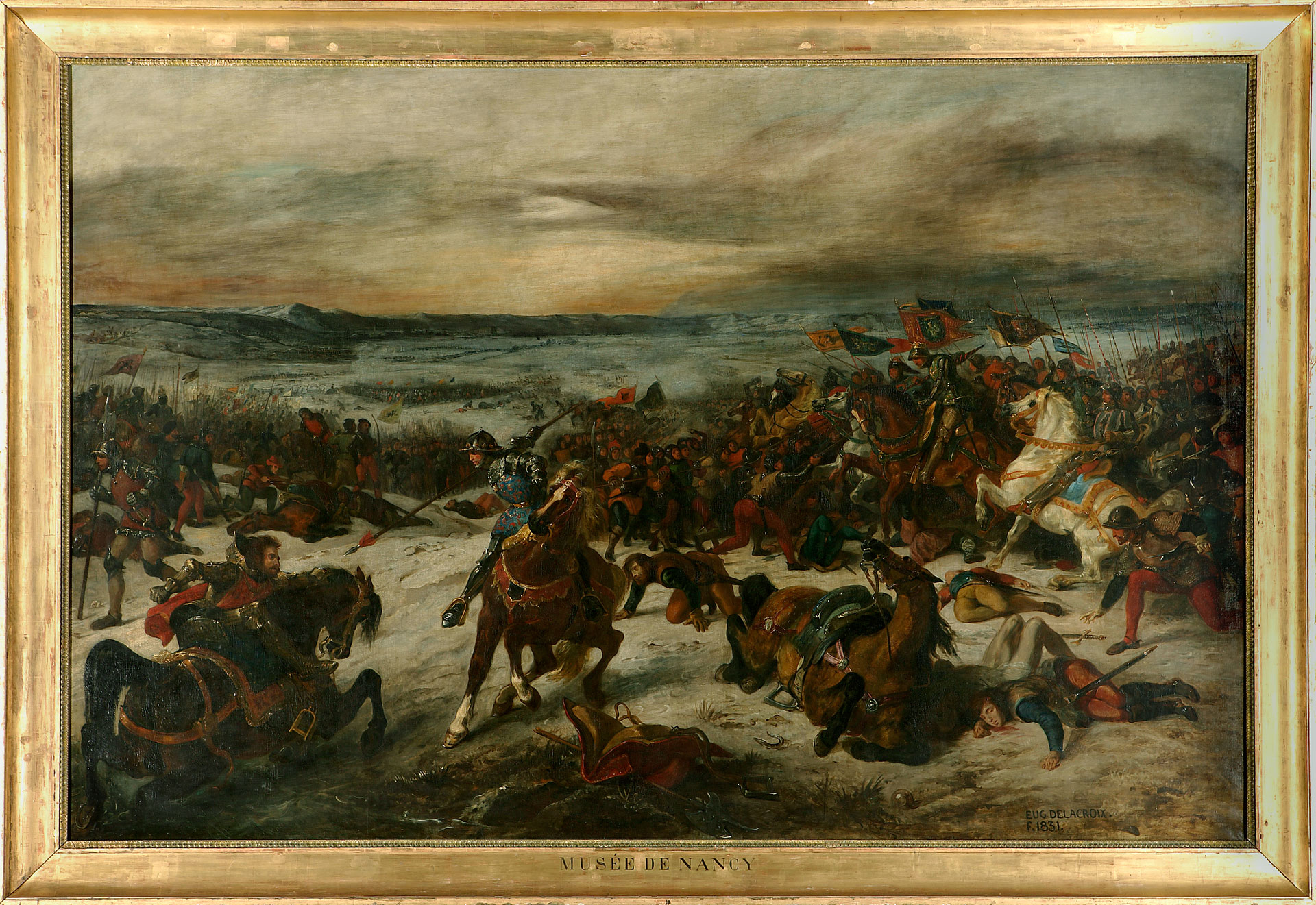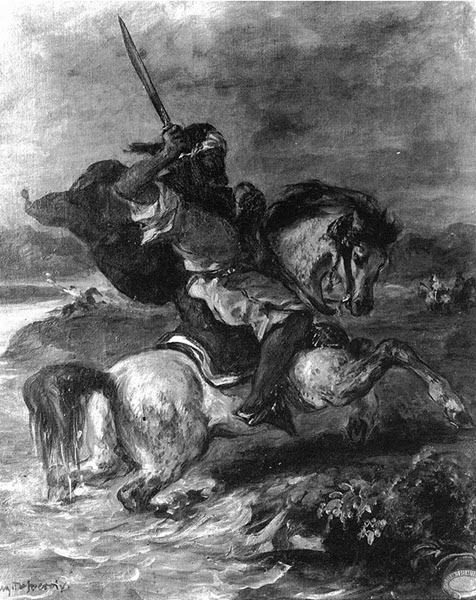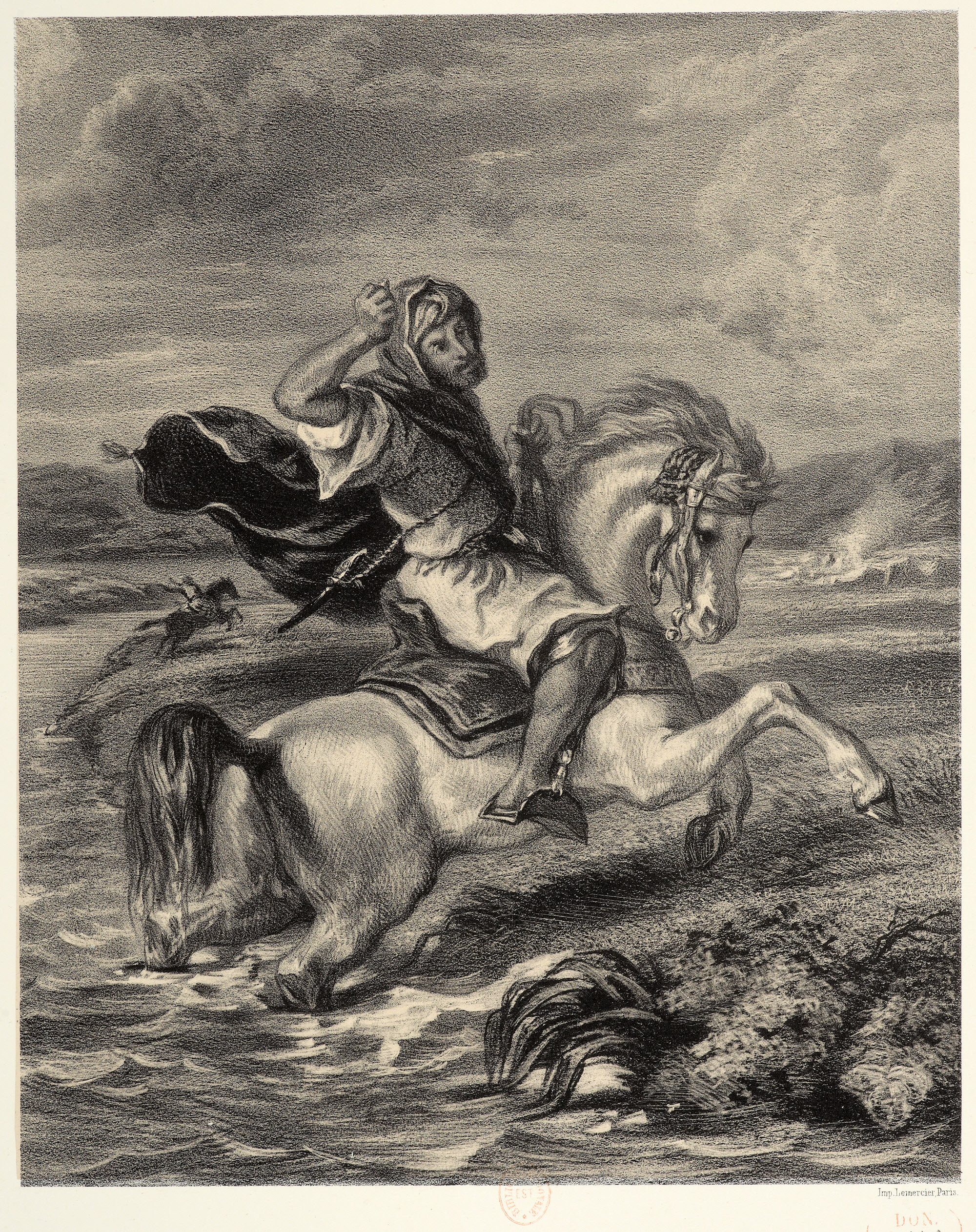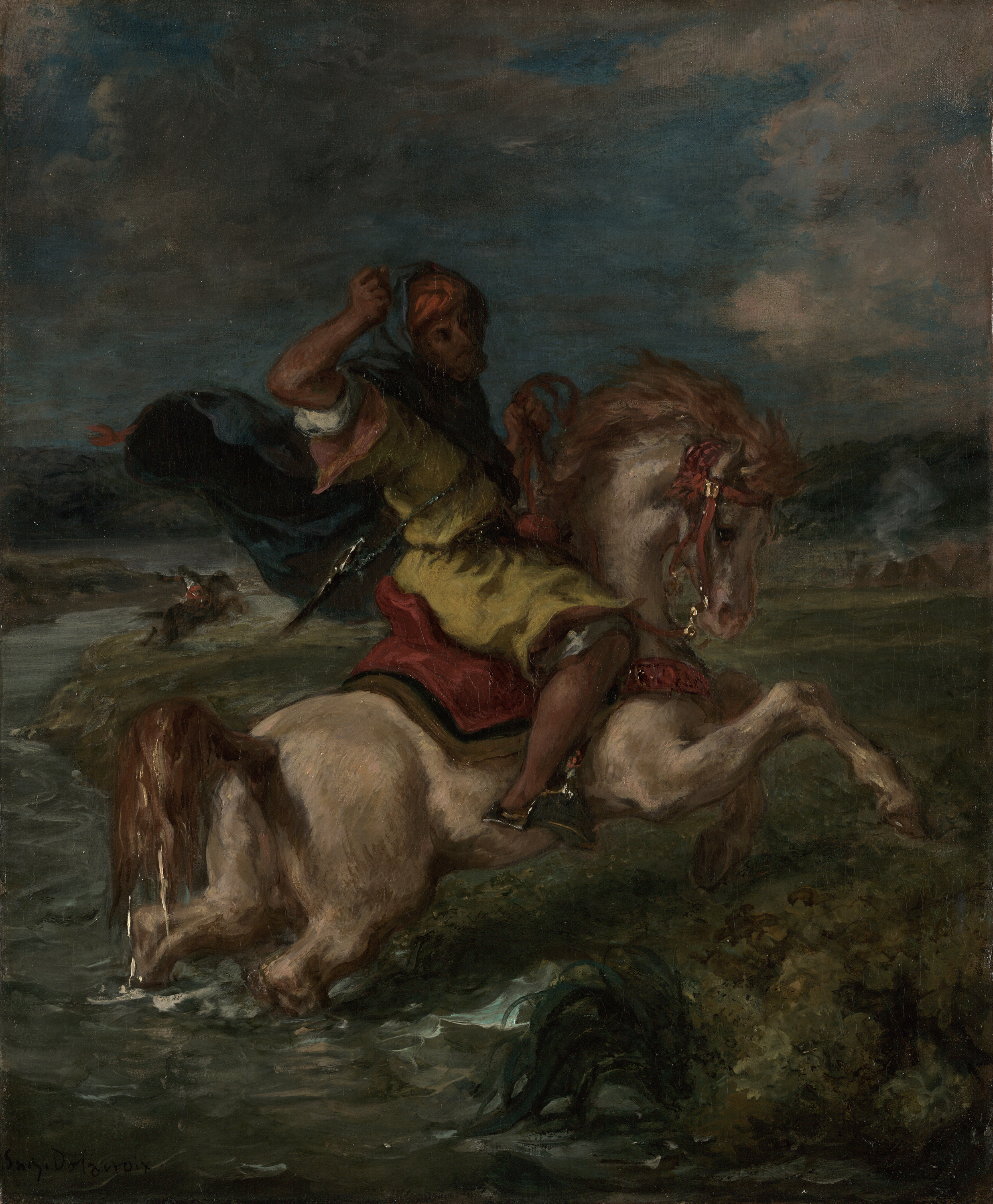Heroically isolated and dramatically lit, an Arab horseman charges across a river, his cloak billowing and his dagger flying behind him. Right fist raised, he grips the reins with his left hand as his rearing mount gains the riverbank. Behind him, the river winds through an expansive, verdant plain bounded by a low-lying chain of mountains obscured by a darkening sky. In the distance another lone horseman, in a fugitive echo of the principal group, sets off at a gallop toward an outlying encampment.
At once a figure of noble bearing and tempestuous passions, the North African cavalier was central to Delacroix’s Orientalist imagination, recurring frequently in his work from the 1830s through the early 1860s. The Moroccan Horseman Crossing a Ford may be grouped with several paintings created between about 1849 and 1855 that focus tightly on a single horse and rider in varying degrees of action or rest.1 These and other so-called fantaisies (fantasies)2 represent a poetic distillation of Delacroix’s firsthand experience of North Africa nearly twenty years prior: in the early months of 1832 he accompanied, as an artistic observer, a diplomatic mission to Morocco led by Comte Charles de Mornay at a particularly sensitive, early stage of France’s colonial venture into neighboring Algeria.3
During Delacroix’s brief sojourn in Morocco, he feverishly filled his sketchbooks with visual notations that were to supply him with documentary material for a lifetime of work. Himself a passionate horseman, Delacroix had ample opportunity to study Arab cavaliers in their bearing, physiognomy, dress, and equipage. He witnessed, for instance, ceremonial courses de poudre (dramatic equestrian displays of firearms), and during the trek from Tangier to Meknes, where the palace of Sultan Abd er-Rahmān was located, Delacroix and the diplomatic retinue were provided with a protective escort of more than a hundred horsemen. In addition to sketching these figures, Delacroix made rapid jottings of river crossings, military encampments, and the rich, mountainous landscape—all of which may have helped inspire this painting.4
Unlike some younger Orientalist painters who came to the fore in the late 1850s and 1860s, Delacroix was not primarily concerned with picturesque local color or detailed ethnographic description. Ever the romantic, he sought a more generalized vision of epic grandeur and elemental passion—the Orient becoming a site for the free exercise of the artist’s, and the viewer’s, imagination. Indeed, Delacroix was convinced that the temporal distance from his initial voyage enabled him to express its significance artistically through the sieve of memory and the synthetic powers of the imagination. As he wrote in his journal on October 17, 1853:
I began to make something tolerable of my African journey only when I had forgotten the trivial details and remembered nothing but the striking and poetic side of the subject. Up to that time, I had been haunted by the passion for accuracy that most people mistake for the truth.5

The specificity of Delacroix’s Moroccan experience was consequently subsumed in his later, more “poetic” work within a free-ranging Orientalist reverie that paid little heed to temporal and geographical distinctions and eroded clear-cut differences between documentary, historical, and literary subjects, between the “real” and the “imaginary.”6 Lacking any specific narrative framework, the Moroccan Horseman Crossing a Ford recalls similarly dramatic equestrian groups that came before it in Delacroix’s art: the literary works inspired by Lord Byron, such as Mazeppa and the Combat between the Giaour and the Pasha;7 the exotic lion- and tiger-hunting scenes that Delacroix painted in enthusiastic homage to Peter Paul Rubens;8 topical works dealing with the Greek war of independence such as Scenes from the Massacre at Chios or Scene from the War between the Turks and the Greeks;9 and even historical compositions like The Battle of Nancy (fig. 1).10 Indeed, the Arab horseman in the Getty picture is similar enough in his heroically defiant attitude to the mounted figure of the fifteenth-century Burgundian leader Charles the Bold in The Battle of Nancy (where he is shown trying to spur his horse out of a pond the moment before he is fatally unseated by a knight of Lorrain) that its anonymous cavalier was actually identified as “Charles le Téméraire” (Charles the Bold) by the first cataloguers of Delacroix’s oeuvre.11
For Delacroix, the processes of poetic condensation and pictorial synthesis were inseparable. Despite its subject’s impetuous turbulence, this painting is remarkable for its carefully meditated artistry. Delacroix masterfully orchestrated the drama of the scene through oppositions of light and color. Threatening shadows encroach on the landscape, punctuated by narrow slivers of light through a few remaining cloud breaks, one of which, like a theatrical spot, illuminates the foreground group. The pale tonality of the horse stands out sharply against the dark, somber landscape, whose dominant blues and greens set off, through complementary contrast, the warm yellow of the rider’s costume and the saturated reds of the saddle, turban, and harness. The scene's coloristic intensity is enhanced by the mercurial energy and variety of Delacroix’s brushwork. The broad massing of areas of light and shadow in the sky and on the plain brings into relief the vivid facture of the foreground, ranging from the fine, nervous, graphic strokes modeling the horse’s body and capturing its bristling, restless energy, to lusciously slick and fluid in describing the water.
For all its romantic colorism and painterliness, Moroccan Horseman Crossing a Ford nevertheless manifests a classical sense of balance and unity, giving it a monumental clarity despite its small dimensions. Formal repetitions bind the composition and reinforce the symbiosis between the horse and the rider, the figures and the landscape. The cavalier’s right arm parallels the right foreleg of his horse; the angle of the rider’s right leg repeats that of his mount’s left foreleg; and his curved, metal stirrup rhymes in beat with the horse’s hooves. Additionally, the horse’s dripping tail repeats the form of the mass of weeds in the immediate foreground, while the animal’s fiery, blowing mane and the horseman’s trailing cloak catch the air in similar rising curves. Such formal echoes never become monotonous, however, since Delacroix alternates concertedly between light and dark tones (as he does between the two horses, one dark and one light). Dynamically unifying the composition, these echoes reinforce one’s sense that the artist was less interested in a specific anecdote than in a more universal drama, binding together in mutual tension man, beast, and the elements.


On account of some brief color notes in Delacroix’s journal, Moroccan Horseman Crossing a Ford has been tentatively dated to 1850. In the entry for June 10 of that year, he makes reference either to this picture or possibly a variant: “Half-tone of the horse, whitish beige (Arab crossing a ford): earth tones, natural and white, silvery gray, white, and brown red: red or yellow predominating, depending on suitability.”12 This places the painting at a moment in Delacroix’s career when he was preoccupied with a major decorative commission for the ceiling of the Gallery of Apollo in the Louvre. As such, it may have been painted in part as a momentary diversion from this project and as a relatively easy way to make some money on the side.13 In his 1853 catalogue of Delacroix’s work, Théophile Silvestre noted that the artist repeated the composition twice, suggesting that there was indeed a good market for these Orientalist “fantasies.”14 Only one such repetition has been identified, however. Although its current location is not known, old photographs indicate that it varied in minor details from the present painting, the most obvious being the inclusion of a drawn sword in the cavalier’s right hand (fig. 2).15
Adolphe Moreau, the first owner of the Getty picture and the first of three generations of Moreaus who dedicated themselves to Delacroix’s art, had it reproduced as a lithograph printed by Lemercier in 1851, along with other notable works in his collection (fig. 3).16 The painting was apparently given to a “Joseph D.” upon Moreau’s death in 1859.17 It is evident from the first scholarly monograph devoted to Delacroix, published in 1873 and written by Moreau’s son, also Adolphe, that the painting was at that point known only through the lithograph, not just because Moreau fils casually misidentified the subject as “Charles the Bold,” but also because he catalogued only the lithograph (under “reproductions”) and not the painting itself.18 The painting was presumed lost until it resurfaced in the 1990s before finally coming on the market in Paris in 2001.19
- Scott C. Allan
-
See, for example, Lee Johnson, The Paintings of Eugène Delacroix: A Critical Catalogue, 6 vols. (Oxford: Clarendon, 1981–89), vol. 3 (1986), nos. 384, 386, 387, 396, 398. ↩︎
-
This term is used by Étienne Moreau-Nelaton in connection with the pictures representing “divers Arabes avec ou sans leur monture” (various Arabs with or without their mounts), which Delacroix produced in the early 1850s. See Delacroix raconté par lui-même, 2 vols. (Paris: H. Laurens, 1916), vol. 2, p. 97. ↩︎
-
For the most thorough account of Delacroix’s North African trip, see Brahim Alaoui et al., Delacroix in Morocco, exh. cat. (Paris: Institut du Monde Arabe, with Flammarion, 1994). ↩︎
-
For a detailed catalogue of Delacroix’s North African studies and sketchbooks, see Maurice Serullaz, Inventaire général des dessins, école française: Dessins d’Eugène Delacroix, 1798–1863, 2 vols. (Paris: Éditions de la Réunion des Musées Nationaux, 1984), vol. 2, pp. 101–79, 360–92. ↩︎
-
“Je n’ai commencé à faire quelque chose de passable, dans mon voyage d’Afrique, qu’au moment où j’avais assez oublié les petits détails pour ne me rappeler dans mes tableaux que le côté frappant et poétique; jusque-là, j’étais poursuivi par l’amour de l’exactitude, que le plus grand nombre prend pour la vérité” (Eugène Delacroix, Journal de Eugène Delacroix, 3 vols., ed. André Joubin [Paris: Librairie Plon, 1932], vol. 2, p. 92). ↩︎
-
On this process of poetic distillation and generalization, see Arlette Serullaz, “The Lesson of Morocco,” in Delacroix: The Late Work, exh. cat. (Philadelphia: Philadelphia Museum of Art, with Thames and Hudson, 1998), p. 248; and Lee Johnson, “The Influence of the Journey on Delacroix’s Art,” in Alaoui et al. 1994 (note 3), p. 118. For a more critical account, see Darcy Grimaldo Grigsby, “Orients and Colonies: Delacroix’s Algerian Harem,” in The Cambridge Companion to Delacroix, ed. Beth S. Wright (Cambridge: Cambridge University Press, 2001), pp. 86–87. ↩︎
-
See, for instance, Johnson 1981–89 (note 1), vol. 1, nos. 114, L.104. The general attitude of the horse in Moroccan Horseman Crossing a Ford closely resembles that of the horse in Mazeppa, a composition that in turn is heavily indebted to Théodore Gericault’s studies for Mazeppa. See Gericault, exh. cat. (Paris: Galeries nationales du Grand Palais, 1991), nos. 291, 292, pls. 314, 317. ↩︎
-
See Johnson 1981–89 (note 1), vol. 3, nos. 181, 194, 199, 204, 205. ↩︎
-
See Johnson 1981–89 (note 1), vol. 1, nos. 105, 115; vol. 3, no. 322. ↩︎
-
For a detailed discussion of the Battle of Nancy, see Johnson 1981–89 (note 1), vol. 1, pp. 140–44, no. 143. ↩︎
-
See Adolphe Moreau, Eugène Delacroix et son œuvre, avec des gravures en fac-simile des planches originales les plus rares (Paris: Librairie des Bibliophiles, 1873), p. 122, no. 40; and Alfred Robaut, L’œuvre complet de Eugène Delacroix: Peintures, dessins, gravures, lithographies (Paris: Charavay Frères, 1885), p. 317, no. 1186. ↩︎
-
“Demi-teinte du Cheval soupe de lait (l’Arabe passant un gué): terre d’ombre naturelle et blanc, antimoine, blanc, et brun rouge: le rouge ou le jaune prédominant, suivant la convenance.” See Delacroix 1932 (note 5), vol. 1, p. 373. ↩︎
-
This is Moreau-Nelaton’s suggestion. See Moreau-Nelaton 1916 (note 2), vol. 2, p. 97. ↩︎
-
Théophile Silvestre, Histoire des artistes vivants français et étrangers. Études d’après nature [ . . . ], Première série, illustrée de 10 portraits pris au daguerréotype et gravés sur acier [ . . . ] (Paris: E. Blanchard, 1853), p. 81. Silvestre lists the picture as “Arabe traversant un gué, répété deux fois,” and dates it to 1852. ↩︎
-
See Johnson 1981–89 (note 1), vol. 3, no. 387 (last recorded in the collection of Pierre Rey-Cathala, in 1930). ↩︎
-
In an 1852 article devoted to Adolphe Moreau’s collection, A. J. du Pays wrote: “M. Adolphe Moreau [ . . . ] fait exécuter par divers lithographes les dessins de ses meilleurs tableaux. Chacun de ces lithographies est tirés a cinquante exemplaires: après quoi le dessin est effacé sur la pierre.” See “Collection particulières—Collection de M. Adolphe Moreau,” L’illustration (September 11, 1852), p. 168. Contrary to du Pays, Johnson asserts that a hundred rather than fifty copies of Moroccan Horseman Crossing a Ford were printed but never published. According to Adolphe Moreau fils, the print bore the dry stamp “Collection Ad. Moreau, 1851,” but Johnson, was not able to corroborate this; the one copy known to him bore no stamp. See Johnson 1981–89 (note 1), vol. 3, p. 282, no. L167. ↩︎
-
See Vincent Pomarède, “Trois générations de Moreau autour de Delacroix,” in De Corot aux Impressionnistes, donations Moreau-Nélaton, exh. cat. (Paris: Galeries nationales du Grand Palais, 1991), p. 46. ↩︎
-
See Moreau 1873 (note 11), p. 122, no. 40. ↩︎
-
Lee Johnson catalogued the painting under “Lost Works” (Johnson 1981–89 [note 1], 3, no. L167). By the time the new edition of this catalogue appeared in 1993, the painting had resurfaced. ↩︎
